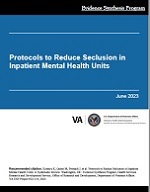
|
Recommended citation: |
Download PDF: Complete Report, Executive Summary, Report, Appendices
We identified 43 protocols to reduce the practice of seclusion in psychiatric inpatient settings. Most were multicomponent complex interventions targeting both patient and staff behaviors to reduce agitation and use of seclusion, respectively. Based on evidence from 37 empirical studies, protocols may reduce the number of seclusion events but we have low confidence in these findings due to the sparsity of data and studies' methodological limitations.
In psychiatric inpatient settings, conflict behaviors (eg, aggression) require immediate intervention to prevent physical and emotional injury to the patient, other patients, and staff. Seclusion is one strategy to manage conflict behaviors although there is concern that it violates patients' rights and autonomy and may cause further psychological harm. In this review, we synthesize the evidence of the effects of the protocols to reduce seclusion in inpatient mental health units.
We identified 43 protocols (37 comparative studies and 6 protocols without data) to reduce seclusion in psychiatric inpatient settings and we categorized them into 5 groups: hospital/unit restructuring (N=4), staff education/training (N=3), sensory rooms (N=7), risk assessment and management protocols (N=7 including 4 studies evaluating the Broset Violence Checklist), and comprehensive/mixed interventions (N=22 including 2 studies evaluating Safewards). Restructuring units to include architecturally positive designs, sensory rooms, Broset Violence Checklist, and comprehensive/mixed interventions may reduce episodes of seclusion. Restructuring units may reduce the use of restraints and forced medication. There is no difference in episodes of restraint for other comprehensive interventions or the Broset Violence Checklist. It is unknown if staff training alone or investigator developed risk assessments reduce seclusion. We have low confidence in the conclusions due to methodological limitations of the studies. Future research should standardize reporting of outcome measures and conducting analyses that account for confounders.
Quinn M, Jutkowitz E, Primack J, et al. Protocols to Reduce Seclusion in Inpatient Mental Health Units. International Journal of Mental Health Nursing. Published online January 9, 2024. DOI: https://doi.org/10.1111/inm.13277.